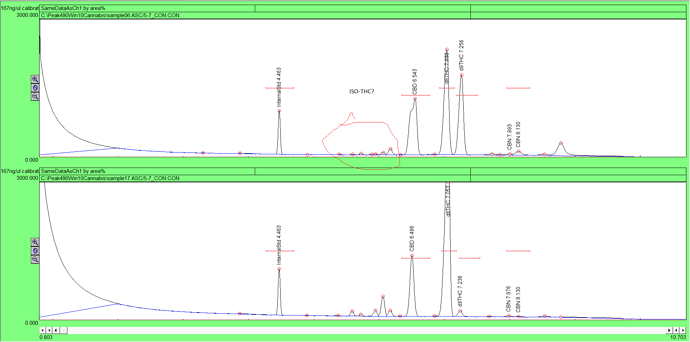Here is a comparison between sample 6 taken at ~1hr 15min into our RXN, and sample 17 taken at about 7.5hr. It interesting that iso-thc production seems to stem from the degradation of d9 into d8 and not from the isomerization of CBD to THC.
There are only two main iso thcs in those reactions, formed stepwise (similarly to d9 to d8).
Looking at your data and knowing the method, I would rather assume that the first iso-d8-thc is the larger peak co-eluting with cbd, and the subsequent iso-d4-8-thc, might be either hidden in the d8 peak, or even what you attribute as CBD… ![]()
Does this cbd peak decreases to a minimum and further stopped there for hours ? I would normally expect the cbd to be gone in the first couple of hours… the kinetic you show is pretty slow. What is the reaction temperature ?
The smaller peaks are likely other things (I see at least 23 here ![]() ), including the v and b version of the d8/d9 thcs and iso thcs.
), including the v and b version of the d8/d9 thcs and iso thcs.
The difference in CBD between the two samples is 8%. It most certainly did stall out after the first hour. I will be upgrading my system with a better pump and use more beads next time. I am almost out of the free samples they sent me so I either need to decide on one or see if I can persuade them to send me different beads that have better or worse performance.
What would you wager that last peak is on sample 6? I noticed that it is produced initially for a while and then fades away to nothing by the end of the RXN.
This is pretty much what I was asking about with my previous question. I assumed since you listed acidified clays that the physical morphology of the clay particles was to blame for the affinity in the conversion.
Indeed, maybe you did not use enough beads regarding your feedstock.
You used a pump. Where you percolating a cbd solution into a column loaded with beads ? Recirculating it ? And what avout the solvent ?
Where you analysing at column outlet ? In the product tank ?
I’m still not very familiar with HPLC methods.
The peaks look broader than others. Could be a bunch unstable intermediary byproducts that further gets broken down, converted to main species, or sorbed on the beads… ![]()
Yes that’s my point. The structure (molecular, or crystaline) influence the properties of the acid groups and also how the reacting molecules can approach it. Plus when it come to natural or synthetic clays, zeolites, or resins, one can expect some heterogeneities in shapes and chemical composition, resulting in more diverse reacting sites.
So I am pumping the RXN solution through a column of beads. I just ordered a gear pump which will allow me to run larger columns with more beads. The chromos I posted was from my SRI GC-FID. Our samples were taken from the bottom of the reactor before it flows into the column. We are agitating the solution so it should have been a pretty good aggregate of the composition of the solution.
Once I get my new pump set up and tested and all that jazz, we will be running again with more beads. Each run we have done has gotten better and yielded more data. We have gotten wayyy better at data collection and sample work up, so each run is giving better results.
My whole goal for these beads is to prove to everyone that synthetic noids do not have to be boogie man poop soup. There are so many noids that are beneficial yet not produced with the current genomics. Geneticists may catch up, or they may not. I believe that having access to these alternative cannabinoids is much more beneficial than not having access. I truly believe in the safety and efficacy of these beads, and I think we are on the cusp of being able to steer this RXN where we want it to go.
